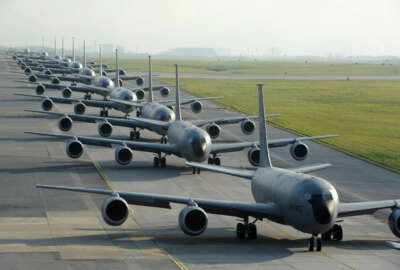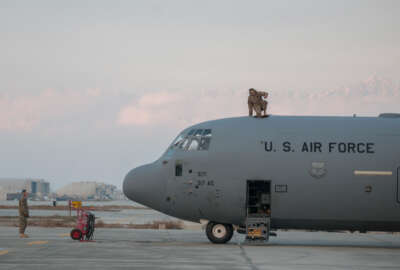Despite relief from budget caps, Air Force hasn’t made headway against readiness shortfall
The Air Force had previously predicted it would be fully ready for high-end conflict by 2025. That date keeps slipping because its pilots and planes are busy in the...
At this time two years ago, the Air Force said it would take until 2023 before it made up for the readiness shortfalls that were caused, in part, by sequestration-induced cuts to its training budget. By one year ago, that date had slipped to 2025. Now, officials believe they’re basically treading water and aren’t even trying to project the year when they’ll achieve the “full spectrum” readiness they believe they need.
“The 2025 timeframe was based on some assumptions that haven’t panned out,” Gen. David Goldfein, the Air Force’s vice chief of staff, told the House Armed Services Committee on Feb. 12. “We assumed we wouldn’t be increasing our activity in Europe, in the Pacific and in Iraq and Syria. As long as that demand signal is there, what you’ll see is a continual, rolling 8-10 year delay in getting to full spectrum readiness. Our prediction is that for the next two-to-three years, we’ll probably be able to just hold our own.”
By “hold our own,” Goldfein meant maintaining the current status at which only about half of the Air Force’s combat units are sufficiently trained for conflict against the sort of high-end adversaries the Pentagon’s 2017 budget emphasizes.
There are myriad reasons why the Air Force hasn’t made much progress in digging out of its readiness hole, despite obtaining relief from the Budget Control Act in every year since 2013. Many of them are not directly related to the sequestration cuts the military services sustained that year, when planes were quickly grounded and civilian employees were furloughed.
One is that despite some growth in active duty forces this year, the Air Force’s fleet and personnel are smaller than ever, and many of the planes, pilots and maintenance personnel that would otherwise be used for training missions are engaged in bombing runs against the Islamic State militants.
“What that means in the F-16, for instance, is that air crews that are trained and designed to do high-end peer-to-peer conflicts in a contested environment are actually spending most of their time flying counterinsurgency missions, and they lose their skills over time,” Goldfein said. “You can’t build that back immediately, because in that community they have to be certified as wingmen, flight leads, instructors. The less time you have to train for all of those, the less readiness you have.”
There’s also the complication of introducing advanced F-35 fighters into the Air Force’s inventory without getting rid of other, older airframes.
The Air Force previously proposed to eliminate the A-10 from its fleet, in part, because it hoped to use A-10 maintainers to work on the F-35. The service acceded to congressional pushback, and in next year’s budget, says it now plans to keep the A-10 flying through 2022. But each aircraft type still needs its own logistics and maintenance infrastructure, and the Air Force estimates it already has 4,000 fewer maintenance technicians than it needs.
“The issue is that we’re bringing in two F-35s in every month and every F-35 requires 20 maintainers, so we’re adding to that deficit every single month,” said Lt. Gen. John Cooper, the deputy chief of staff for logistics, engineering and force protection. “We’ve offered numerous retention incentives so that our older maintainers will stay in, but we’re still digging a hole because we have a force structure we can’t divest.”
Also, as with the other military services, most of the 2013 cuts required by sequestration came from the Air Force accounts that most directly impact its people. One effect of that was to cut back on recruiting for civilian and uniformed maintenance personnel.
“We’re reversing that trend now at the expense of other critical career fields, and our new budget asks for a growth of maintainers, and we’re also looking to contract some of the work out in certain locations if the market is right,” Cooper said. “But that strategy only gets us through about two years, and we’ll have the same problem in another two years.”
The Air Force also counts the condition of its bases among its readiness challenges. It already has $22 billion in deferred maintenance across its facility portfolio, and the 2017 budget the service proposed last week wouldn’t help matters; it left sustainment, restoration and modernization funding at bare bones levels. The rationale, officials said, was to preserve as much funding as possible to add more flight training and other pressing combat readiness needs.
The limited spending the service plans on facility sustainment will be focused mostly on projects that are deemed most necessary for military operations, and will come at the expense of other base facilities like child care centers, dining halls and gymnasiums.
“It pushes us into a strategy of ‘worst first,’” Cooper said. “And focusing on our worst problems first means our priority has to be on the things that directly affect our mission requirements. Unfortunately, quality of life is competing against mission requirements.”
Even if the Air Force had found sufficient funding to dig out of its massive facility maintenance backlog, officials said those dollars would be spread far too thinly than necessary because of the excess base infrastructure the service is required to maintain while Congress continually declines DoD requests for base closures.
The Air Force believes it has 30 percent more facilities than it could use even under its best budget scenario, and that the dollars wasted to maintain unnecessary facilities also has an impact on its readiness posture.
“We’re avoiding $2.9 billion in expenses every year from the BRAC rounds we’ve already done,” Cooper said. “We have too much, it’s too old and it’s too expensive. I could give you a litany of testimonials, but for one, at Keessler Air Force Base, where we train our pilots, we have a 50-year-old drainage system that can’t handle large rains. So about three times a year, it floods, and we can’t conduct pilot training. We lost 370 sorties last year just because it rained. That facility project is still competing for funds because there’s not enough to go around.”
Copyright © 2025 Federal News Network. All rights reserved. This website is not intended for users located within the European Economic Area.
Jared Serbu is deputy editor of Federal News Network and reports on the Defense Department’s contracting, legislative, workforce and IT issues.
Follow @jserbuWFED






